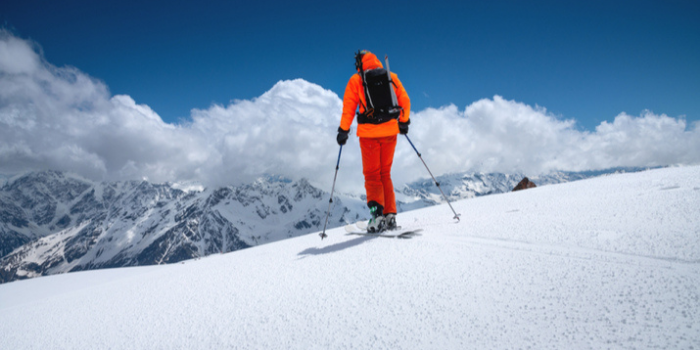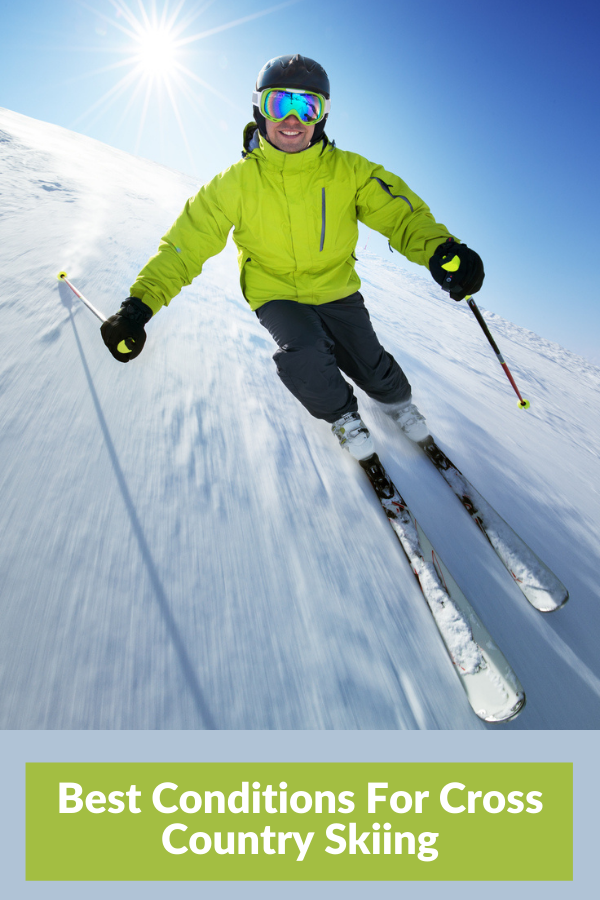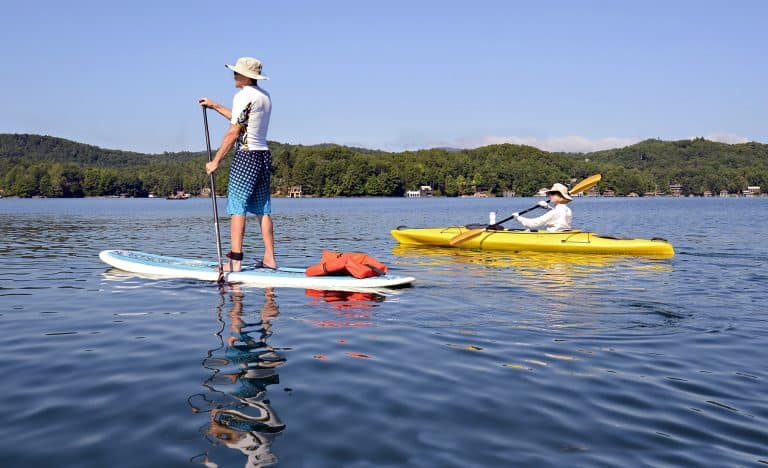Managing to time your day off with the best conditions for cross country skiing is often down to planning and good luck.
However, the unpredictable weather conditions in the mountains may mean that the conditions are less than favorable.
When you are a beginner at any outdoor sport, you will often go out whatever the weather. This is because you are fuelled by enthusiasm and the fact you want to make the most of your time off.
As you become more proficient, you may become pickier about when you go out. You will probably save your cross country skiing for when the weather and snow conditions are perfect.
How Snow Conditions Vary
When the planets align and your day off coincides with the best conditions for cross country skiing, you will have an incredible day. The snow is just the right consistency to allow you to glide and push against, while the visibility and temperature are perfect.
The perfect snow for cross country skiing isn’t too firm or too soft. But there are a few things that determine snow quality.
For example, the air temperature when the snow fell, how long ago the snow fell, and if the air temperature has got above freezing on the day you want to ski.
Snow melts and freezes over time, which is a process that constantly changes the snow’s consistency. Usually, it will start off firm in the morning and then progressively soften up during the day.
When the snow is at its coldest, its crystals are sharp, which doesn’t allow your skis to run efficiently. Snow that is wet but has frozen allows your skis to slide easily, allowing you to go much faster. However, melted snow is sticky, adding resistance to your skis’ bases, slowing you down.
If you go cross-country skiing on groomed tracks, you may notice the quality of the snow is affected by the grooming machines, especially during spring. Ski resorts groom the trails at night when the temperatures are colder, making the snow nice and uniform for the morning.
But when it is snowing, the resorts groom the tracks in the morning. Sometimes they will need to keep the snow machines running all day to keep on top of the slope maintenance.
If a big dump of snow lasts all day, you will need to adjust your technique to ski in powder snow. Alpine skiers and snowboarders love powder, but cross-country skiers find it challenging.
Getting The Perfect Snow
To get the best snow of the day, you need to be aware of the air temperature. If it is a sunny day, you are best to get out reasonably early, especially if your route gets lots of sun.
When the snow is at its optimum quality, it will allow the skis to run fast, but it will also be very forgiving. It makes skiing both uphill and downhill fun, providing you with lots of entertainment.
However, the perfect snow doesn’t last long. There will be a point where it peaks in quality before it starts to degrade.
After the snow passes its sweet spot, it will start to become softer and sticky. Therefore, your skis won’t run as efficiently.
It is very rare that 100% of the snow you encounter will be perfect. This is because different sections of your route will have different levels of exposure to sun and wind.
You will likely come across icy patches and slushy sections between the areas where the snow is perfect. The time of winter will also have a significant effect on the snow quality for cross country skiing.
Early Winter
During the early part of winter, the snow coverage won’t be particularly deep. There is a good chance that you will encounter very hard and shiny snow; in fact, it will be more like ice than snow.
The early season snow can be sporadic, so you don’t get regular top-ups of quality snow. During this time, the temperatures are very cold too, making what snow you have very firm.
The problem with snow being this hard is that it is very slippery, making steep sections tricky and dangerous.
To get the best conditions for cross country skiing during early winter, it is best to go out later in the day. The snow will have had time to soften up in the warmer temperatures.
Midwinter
During the middle of the winter, the snowfall is often more frequent. If you get a good dump of snow overnight, wait and give the snow grooming machines time to do their jobs.
Also, you may want to wait a day or so to allow the snow to settle and become less heavy. But when it snows a lot, going cross country skiing after the tracks have been groomed is the best tactic.
Spring Conditions
During the springtime, the snow will be very firm in the mornings. The cold overnight temperatures will have frozen the slush from the previous day.
When you want to go cross country skiing in springtime, give it a couple of hours for the snow to soften up. If you get it right, you will be able to catch the snow at its optimum consistency.
If you leave your springtime cross country skiing too late in the day, the snow will be extremely sticky. When the snow is this sticky, cross country skiing is not much fun.
Cross Country Skiing In Less Than Perfect Conditions
Due to how variable the snow conditions can be, you need to adapt your technique to suit the different types of snow.
The best way to become proficient at cross country skiing in all conditions is to just get out there and experience it. You will learn by doing, but here are some tips:
In Deep Powder
If there has been a significant overnight snowfall, the snow will be dry and fluffy in the morning, thanks to the cold temperatures. Cross country skiing in these conditions is very pleasant; however, it is slow progress.
You would be better off alpine skiing or going into the backcountry on a powder day. You will have lots of fun while the cross country ski tracks have time to settle and for the machines to groom them.
If the new powder snow is sitting on top of groomed tracks, you will be able to power through the fresh snow. Your skis will sink below the surface, so you will need to put in lots of effort to get through.
Cross country skiing in powder is an excellent workout, but you won’t be traveling very fast. The best thing to do is power on while admiring the scenery.
After a couple of days, the powder will become more firm, especially when the machines have groomed it. You won’t need to power through the snow, as you will be able to stay on top of it. You will also be able to go much faster, and the experience is much more pleasant.
If you prefer skate skiing, you should wait until the tracks are groomed. Groomed tracks are much better, as they are ideally suited for skate skiing.
When the nighttime temperature is below zero, but it is relatively warm during the day, keep an eye on the off-piste areas. The untouched snow can become firm enough to ski on, even if it hasn’t snowed for a while.
These conditions allow you to explore different areas. You will be able to ski through meadows, spotting wildlife, without your skis getting buried in the snow, making it hard work.
On Uneven Snow
Most skate skiers don’t like to ski on frozen or uneven snow, as it is challenging to balance on. However, if you have the time, you can use these conditions to fine-tune your technique and work out if you glide properly on your skis.
If you stay on your edges rather than use the bases of your skis, you will have trouble. By ensuring your skis are flat and pointing forwards, they will glide over the tricky surface much more easily.
When you skate, you should work on landing on a flat ski. You will find that you will glide forwards much more effectively than if you land on your edges.
The thing about cross-country skis is that they don’t have metal edges like alpine skis. Edges are for giving you purchase and bite when carving or stopping when skiing downhill.
Cross-country ski manufacturers try to make their skis as light as possible. Therefore, they don’t fit metal edges to them.
In addition to this, as a cross-country skier, you don’t really need metal edges. The proper technique consists of a kick, followed by a glide.
If you were to use your edges while cross country skiing, you will lose momentum. This is because the edges will dig sideways into the snow, slowing you down.
On Ice
Icy cross-country ski tracks can be intimidating. But, once you have got to grips with them, you can have lots of fun, as you can ski very fast and smoothly on them.
Many people who ski on icy tracks for the first time tend to be too conservative with their technique. This is understandable, as being less committed in most sports keeps you safe.
However, keeping your strides short and not shifting your weight enough has the opposite effect. The problem with cross-country skiing in this way is that your skis don’t land flat on the ice.
Using your edges rather than flat skis makes controlling them difficult, as they are less stable. Therefore, you need to use a similar technique when skiing on uneven surfaces.
You need to ensure all of your weight is on the ski, so its whole base is in contact with the ice. This gives you much more cohesion with the ice and more glide.
When you glide further, you will get past the icy sections much more quickly. Also, your technique will be more efficient as you stride less and go faster.
A good test for your technique is to check how your body is lined up when your weight is all on one ski. Your hip, knee, and ski should all be in line with each other.
When everything is aligned as it should be, you will be in the strongest position.
Your technique will be much more efficient and graceful with a flat base when you fully commit to shifting your weight onto each ski. But when it comes to slowing down or stopping, it is best to turn sideways like you are on alpine skis, rather than a full-on snowplow stop.
Honing Your Skills
Cross-Country skiing on all types of snow takes time and practice. You can concentrate on specific elements of your technique by not using your poles.
By forgetting about your poles, you can get used to the feeling of making sure all of your weight is on each ski. You will need to balance on one ski, which is challenging but worth concentrating on.
There is a good chance you will fall, but this is all part of learning and training yourself to cope with different snow conditions.
Why You Should Go Cross-Country Skiing In Bad Conditions
If the conditions are less than favorable, you should still go cross-country skiing. Obviously, if the conditions are dangerous, you should stay indoors.
But, as long as you wear the appropriate clothing, you can get an hour of practice in. You will achieve more in an hour on the track than you will sitting indoors.
Practicing in awkward snow conditions improves your balance. If you can master cross country skiing on poor surfaces, you will find it much easier when you get on groomed tracks.
The other advantage of going out when the conditions are not great is that you will likely have the track to yourself. Therefore, you won’t have an audience when you get it wrong and fall.
In addition to this, you will gain valuable experience. For example, you will learn what layers to wear and how your equipment performs in different situations.
How To Prepare For Cross Country Skiing In Any Conditions
Now you know all about the different conditions for cross-country skiing, we will give you some tips about preparing for your day on the skis.
Wax Your Cross Country Skis
Cross country skis require two types of wax. The first type is glide wax that allows your skis to slide forwards. You should get a ski shop to apply this for you once or twice every season.
The second type of wax is grip wax. You need to get the correct grip wax, so you can apply it to your skis each time you hit the track.
There are a few different types of grip wax, but they are all designed to work in specific temperature ranges. Therefore, you should apply the wax to suit the conditions you are skiing in.
Check The Weather Report
You already know how the different types of snow conditions will affect your skiing. But, keeping an eye on the weather forecast will keep you informed on what to expect.
You will also know what to wear when you are skiing. It is best to start off cold, as you will warm up as you ski.
Plan Your Outfit
Wearing the appropriate clothing for the conditions is essential. Cross-country skiers work hard and build up a lot of body heat in the process.
Your clothing choice should shield you from the elements, but it should also wick moisture away from your skin. If moisture stays on your skin, in extreme cases, you can get so cold that you run the risk of hypothermia when you stop.
The best clothing tactic when cross-country skiing is to wear several lightweight and technical layers. By wearing layers, you can add or remove them to suit the temperature.
Your outfit should consist of a base layer, which is in contact with your skin. It will be made from synthetic or natural materials that remove moisture from your skin.
On top of your base layer, you need a mid-layer. Often, mid-layers are lightweight fleece or down jackets.
If it is snowing or raining, you will want to wear an outer layer. It is best to choose a breathable and lightweight waterproof jacket for the best results.
You probably won’t want anything too insulated while you are cross-country skiing. Thick clothing will cause you to overheat very quickly, and you will start stripping off layers within a few minutes.
When you are cross-country skiing, you need to ensure you are comfortable. By experimenting with different layers, you will work out what is best for you and the conditions.
It can be very tempting to just put up with being too hot or cold. Getting layers out and putting them in your backpack can be frustrating and break your flow.
But, if you don’t manage your body temperature properly, you will become uncomfortable. You may dehydrate or get so cold, you don’t enjoy your skiing.
Good ski jackets are packed full of features to keep you comfortable. So when you choose your outer layer, make sure you buy one that is versatile, with vents to allow warm air to escape.
Carry A Backpack
You can carry all sorts of things in a backpack that you may need for a day of cross-country skiing. For example, you can take extra clothing, extra wax, a snow shovel, food, and drink.
If you buy a larger backpack, you will be able to carry more things to help you out when things go wrong. Some cross-country skiers like to have a multitool to fix bindings or even duct tape to temporarily repair damaged boots.
It is also a good idea to pack a head torch, especially if you go out later in the day or for a long tour. A head torch can be invaluable if the unexpected happens and you are out for longer than planned.
Cross-country skiing is one of the safer skiing disciplines, but if you carry a backpack, you may want to pack a first-aid kit. It is always good to be prepared for every eventuality.
If you are on a groomed track, you may be able to leave your backpack in your car close at hand or stash it in a safe place. But if you are heading into the backcountry, you will need to carry it with you.
For some backcountry routes, you may need to take avalanche equipment in case of an emergency. The complete kit will consist of a transceiver, probe, and shovel, but you should know how to use them before you go.
Protect Yourself From The Sun
When combined with snow, the sun is much harsher. You need to protect yourself from direct sunlight but also from the UV rays reflecting off the snow.
You don’t need to be cross-country skiing on a sunny day to get sunburned. UV rays penetrate light cloud cover, so wearing a good sunscreen is a good idea.
Don’t forget to apply sunscreen to your arms if you roll your sleeves up or go down to a t-shirt.
It is essential to protect your eyes when cross-country skiing. The glare from the snow can cause snow blindness, which is very unpleasant.
Final Thoughts
The best conditions for cross-country skiing are on blue sky days and when the air temperature and snow are just right. When these conditions are combined with stunning scenery, you are in for a great day.
But, as you can see, you can go cross-country skiing in different conditions. By ensuring that you are dressed appropriately and understand how to adjust your technique, you can still have a good time.
The days when the conditions are not so good give you the opportunity to practice your skills or develop new ones. The more time you spend cross-country skiing, the more familiar you will get with it.
Getting out on the days that most people avoid will help you enjoy the good days much more.
Images from Shutterstock























